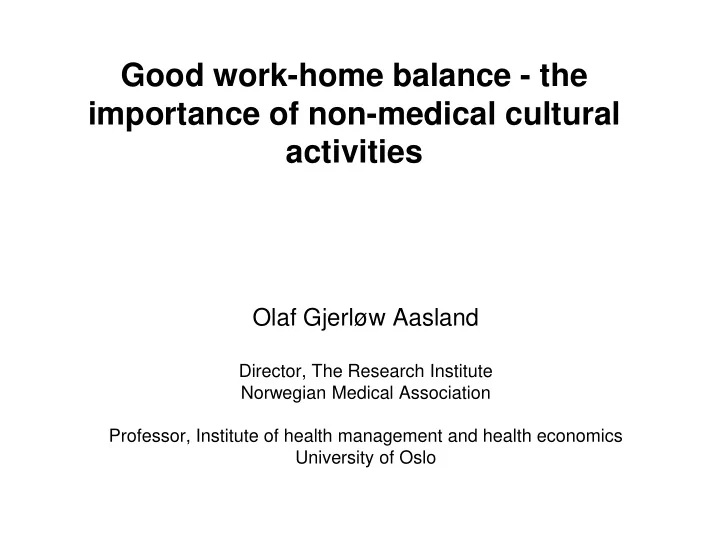

Good work-home balance - the importance of non-medical cultural activities Olaf Gjerløw Aasland Director, The Research Institute Norwegian Medical Association Professor, Institute of health management and health economics University of Oslo
Data • Reserach on work-home balance and stress/burnout, data from 2003 and 2005 – Ellen Mellbye Langballe, Siw-Tone Innstrand, Erik Falkum, Olaf G Aasland • Research on Norwegian doctors ’ cultural activities, data from 1994 and 2012. – Magne Nylenna, Erik Falkum, Olaf G Aasland
The Norwegian burnout study females males females males 368/500 315/500 291/368 232/315 Doctors 342/500 342/500 278/342 218/342 Nurses 312/500 276/500 218/312 194/342 Lawyers 342/500 342/500 247/342 257/342 Teachers 263/401 411/500 190/263 310/411 Church ministers 297/500 286/500 191/297 190/286 Bus drivers 318/500 282/500 186/318 172/282 Information technology 289/500 227/500 166/289 138/227 Advertisement October 2003 October 2005
Operationalisation of burnout I, response variables: • Two dimensions from the Oldenburg Burnout Inventory (OLBI) – Exhaustion (OLBI-e,8 items) • Feelings of emotional emptiness, overtaxing from work, strong need for rest and a state of physical exhaustione – e.g. ” After my work, I regularly feel worn out and weary ” – Disengangement from work (OLBI-d, 8 items) • Distancing oneself from one ’ s work, negative attitudes and behaviour toward work in general, work contents and object – e.g. ” I cannot imagine another occupation for myself ” (R)
Burnout-scores (OLBI), Norwegian sample, 2003 2,3 Teachers 2,89 2,55 Bus drivers 2,75 1,98 Religious mnisters 2,74 2,07 DOCTORS 2,74 2,55 Advertisement 2,73 2,31 Nurses 2,69 2,5 IT-consultants 2,63 2,17 Lawyers 2,57 Emotional exhaustion Detachment from work
Operationalisation of burnout II: Main effect variables: • Individual factors – Job performance-based self-esteem (PBSE) • How close is an individual ’ s identity related to work achievements? – Job self-efficacy • The confidence in the ability to perform well at work • Work-related factors – Workload – Work hours – Time pressure – Role conflict – Lack of autonomy • Work-home related factors – Facilitation – Conflict
Conclusions: The experience of burnout seems to be quite stable, at least over a two-year period, and even if some of the possible causes may change. Workload and work-home conflict are important predictive factors that have to be taken into consideration when dealing with doctors ’ burnout. Doctors work long hours and are therefore likely candidates for overcrowded schedules that may generate excessive workload and work-home pressure. For both males and females, high acceptance of work place values seem to protect against burnout.
Probabiity of having a doctor partner NMA Masterfile 1999 (N=20 046) 40% 30% Females 20% 10% Males 1910 1930 1950 1970 1990 2010 Year of graduation from medical school
As in 1993, we measured the doctors ’ cultural Cultural index activity with the aid of an index which is based on 20,0 self-reported reading of non-medical literature for more than 20 minutes over the past day, playing a 18,0 musical instrument, playing in an orchestra or singing in a choir (1 point for each of the three 16,0 activities). Similarly, points were scored for visits to the cinema, theatre, opera and concerts of classical or popular music (1 point for 1 – 4 visits 14,0 and 2 points for five or more visits over the last 12 months). The maximum possible score on this 12,0 index is 13 points. 10,0 1994 2010 8,0 6,0 4,0 2,0 ,0 0 1 2 3 4 5 6 7 8 9 10 11 12 13
The average cultural index score for women was 4.8 (95 % CI: 4.6 – 5.0) and 4.6 (95 % CI: 4.4 – 4.7) for men. The corresponding figures for 1993 were 4.5 (95 % CI: 4.2 – 4.7) for women and 4.1 (95 % CI: 3.9 – 4.2) for men ( 9). In other words, the cultural index scores have increased for both men and women doctors from 1993 to 2010, and for the men this increase is statistically significant. We found significant positive correlations between the cultural index scores and job satisfaction (ρ = 0.105, p = 0.002, n = 884), general satisfaction (ρ = 0.071, p = 0.033, n = 903), self- reported health (ρ = 0.084, p = 0.013, n = 881) and exercise and other forms of physical activity (ρ = 0.171, p < 0.001, n = 904). Moreover, the cultural index scores were negatively correlated to job- related stress (ρ = – 0.102, p = 0.003, n = 866).
Recommend
More recommend